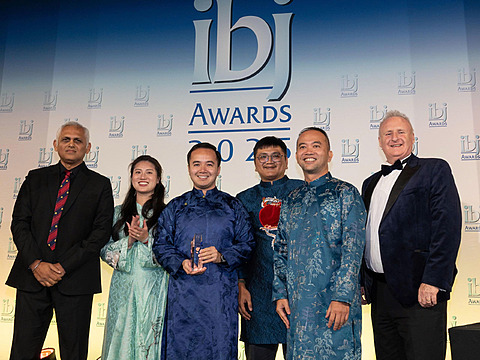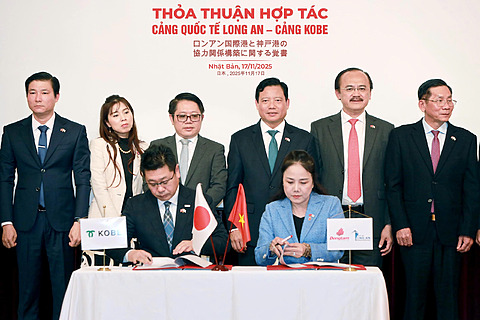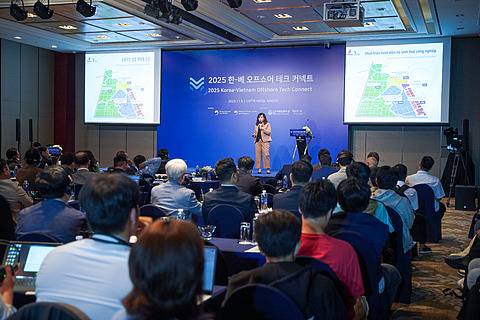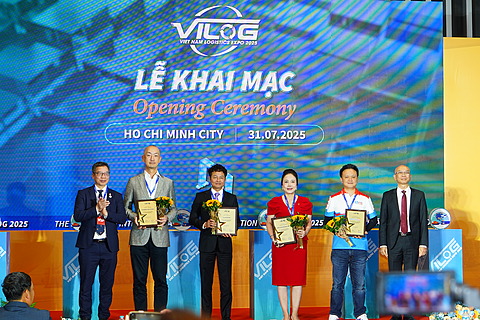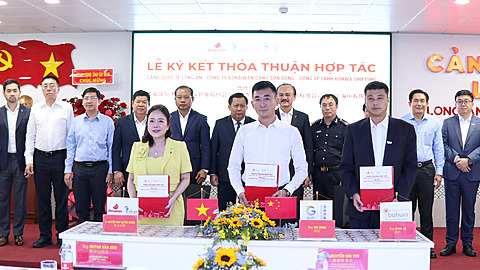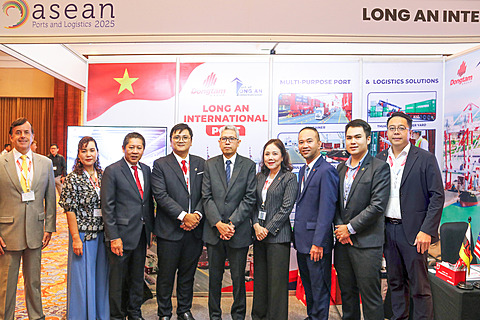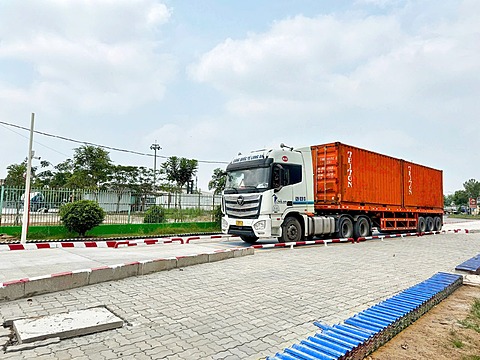
Delegates taking a commemorative photo at the Vietnam–Cambodia Production, Distribution, and Logistics Networking Conference on September 13, 2025.
Long An International Port delivered a strong message on its pivotal role in regional supply chain integration and development while also recommending its inclusion in the list of regulated waterways, transit routes, ports, terminals, and port clusters under the Agreement.
On September 13 in Tan Ninh Ward, the Ministry of Industry and Trade (MOIT) and the People’s Committee of Tay Ninh Province, in coordination with the Ministry of Commerce of the Kingdom of Cambodia, organized the Vietnam–Cambodia Production, Distribution, and Logistics Business Connectivity Conference. The conference was co-chaired by Ms. Phan Thi Thang, Deputy Minister of Industry and Trade; Mr. Nguyen Hong Thanh, Standing Member of the Tay Ninh Provincial Party Committee and Vice Chairman of the Tay Ninh People’s Committee; and H.E. Tith Rithipol, Undersecretary of State of the Cambodian Ministry of Commerce. The event attracted over 200 delegates, including representatives from the Central Party, central ministries and agencies, leaders from departments of eight Vietnamese border provinces and nine Cambodian border provinces, as well as enterprises and industry associations from both countries.

Deputy Minister of Industry and Trade Phan Thi Thang delivers the opening remarks at the Vietnam–Cambodia Production, Distribution, and Logistics Networking Conference
In her opening speech, Deputy Minister Phan Thi Thang emphasized that, in recent years, Vietnam and Cambodia have signed a series of bilateral cooperation agreements that provide a legal framework and favorable conditions for cross-border trade. These agreements have contributed to the development of border gate infrastructure, border markets, warehouses, and logistics services in border provinces, helping to shorten customs clearance times and strengthen supply chain connectivity. In 2024, two-way trade turnover reached approximately USD 10.1 billion, up 17.5%. By July 2025, bilateral trade had already exceeded USD 7 billion, an increase of 16.3% compared to the same period in 2024. Industrial and energy products dominate Vietnam’s exports, while agricultural products account for majority of imports from Cambodia.
At the conference, ministries, agencies, associations, and enterprises from both Vietnam and Cambodia delivered 17 presentations, discussing solutions to promote bilateral trade. They shared practical experiences and proposed measures to enhance cross-border trade infrastructure between Vietnam and Cambodia, aiming to build an integrated network of production, distribution, and logistics enterprises.

Ms. Ngo Thi Thanh Vy, Board Member and Deputy General Director of Long An International Port Management & Operations JSC
In her presentation, Ngo Thị Thanh Vy introduced the port cluster’s comprehensive, synchronized, and sustainable development ecosystem. She highlighted the port’s strategic position as a logistics gateway directly connecting to the global supply chain.


Ms. Ngo Thi Thanh Vy, representing Long An International Port, delivers a presentation at the conference.
With modern, large-scale, and environmentally friendly infrastructure, along with a fully integrated warehouse and logistics system, Long An International Port is ready to meet the demand for cargo transshipment between Cambodia and Vietnam to international markets. Aiming to become a leading logistics hub in the region, the port not only optimizes costs and time while minimizing risks, but also enhances competitiveness and delivers tangible added value for businesses.
She emphasized the strong demand for cargo transshipment from Vietnam to Cambodia, with projected volumes of 50,000–100,000 tons per year, mainly fertilizers, agricultural products, and animal feed. Based on this, the port proposed that central ministries, agencies, and the Tay Ninh provincial government “Include Long An International Port in the list of regulated waterways, transit routes, ports, and terminals under the Vietnam–Cambodia Waterway Transport Agreement, to facilitate multimodal international transport from Cambodia through Vietnam to global markets; expand cross-border logistics corridors; and enhance the competitiveness of enterprises from both countries in the regional supply chain in Asia,” Ms. Vy stated.

Delegates taking a commemorative photo at the Vietnam–Cambodia Production, Distribution, and Logistics Networking Conference.

Visitors explore the range of services at Long An International Port
The event not only served as a forum to foster deeper connections among businesses but also opened prospects for developing modern logistics hubs linked to border trade in Tay Ninh. In this context, Long An International Port is seen as a strategic gateway, helping to realize the goal of turning the Vietnam–Cambodia border region into a new growth engine for regional and global supply chains.
The Ministry of Industry and Trade has issued Decision No. 2162/QD-BCT, aiming to raise bilateral trade turnover to USD 20 billion by 2030. By 2027, the goal is for 100% of warehouses at border gates to meet cargo storage needs, with at least 80% offering full-package logistics services, effectively connecting with regional and international supply chains.
